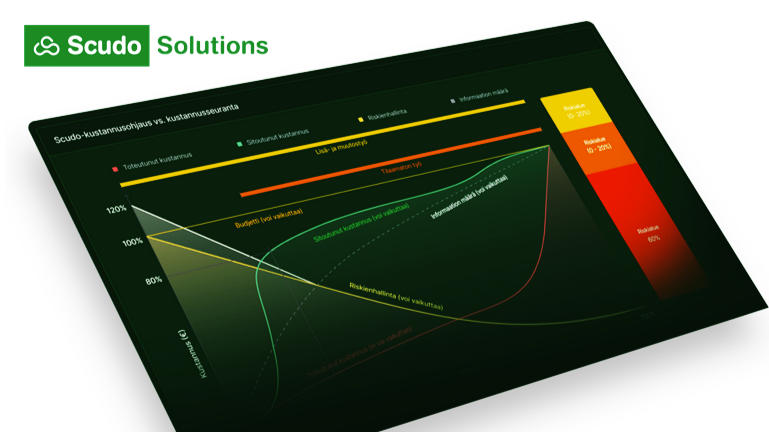
Scudo Solutions Oy
322 followers
November 4, 2024
The Financial Perspective of Digital Cost Control in Project Business
The significance of digitalization in project-based business has grown substantially in recent decades. As a result, cost control has become a particularly valuable tool for optimizing financial performance. Predictive analytics, real-time data, dashboard views, seamless integrations between core systems, and forecasting models (such as S-curves, Monte Carlo simulations, and Latin hypercube sampling) provide projects with the ability to anticipate and respond quickly to financial deviations. This reduces budget overruns and resource inefficiencies.
From a financial standpoint, digital cost control enables greater cost-efficiency than traditional cost tracking, which is largely reactive, limited in scope, and lacks predictive capabilities.
Project business frequently exceeds budgets
Budget overruns have significant financial consequences, weakening profitability, organizational resilience, and return on investment (ROI)—even impacting public funding in taxpayer-funded projects.
According to McKinsey (2015), infrastructure projects exceed budgets by an average of 80%, and up to 98% go over the original budget—an alarming margin of error that often leads to project failure.
Similarly, Flyvbjerg (2014) found that 70% of all projects exceed their budgets by at least 5%, increasing costs and jeopardizing financial success. These findings align with numerous Finnish studies in construction and real estate sectors.
Cost control is the key function that helps manage and mitigate these financial risks through predictive data analysis, ensuring more accurate budget management and improved financial outcomes.
Digital cost control increases project cost-efficiency by an average of 23%
Digital tools—real-time graphics, alerts, notifications—enable tighter cost control, reducing the risk of unexpected financial deviations.
According to IBM (2018), digital cost control systems can increase project cost-efficiency by up to 23%. In practice, this means fewer financial losses and improved resource utilization.
This a significant benefit compared to the relatively low investment required for these tools.
Cost control allows for proactive resource management, maximizing project returns and avoiding unnecessary expenses. This results in a higher ROI and greater financial flexibility for the organization.
Cost Control Outperforms Cost Tracking
From a financial perspective, cost control is a superior process to cost tracking in project execution. While cost tracking merely reports on historical costs, it lacks the agility and foresight needed to respond to financial changes—often leading to budget overruns.
Cost control, by contrast, leverages real-time tools and predictive models that enable proactive financial steering and risk minimization, contributing to more profitable and sustainable project operations (Nguyen et al., 2004).
Long-Term Financial Sustainability and Lifecycle Cost Management
Digital cost control also enhances long-term financial sustainability by factoring in lifecycle costs. This is especially valuable in construction and real estate projects, where long-term resource costs impact overall investment returns and risk management.
Lifecycle cost management reduces waste and ensures investments remain financially viable over time, supporting the economic goals of investors and corporate leadership (Love et al., 2022).
Digital cost control is a superior tool in project business
The capabilities offered by digitalization make cost control a financially superior tool compared to traditional cost tracking.
Cost control utilizes real-time data, predictive models, and statistical analysis to improve budget accuracy, enhance risk management, and enable corrective action—reducing financial risks and increasing cost-efficiency. This leads to better ROI, long-term financial sustainability, and ultimately more successful project outcomes.
Scudo Pro cloud service provides a concrete example of digital cost control in action. It delivers real-time financial management—tracking, controlling, analyzing, and reporting—through automated, up-to-date dashboards, ease of use, and cloud-based modern technology. With Scudo Pro, project managers, executives, key personnel, and project teams can anticipate and manage financial deviations, respond immediately, and consistently improve financial performance while minimizing the risk of budget overruns—ultimately saving substantial amounts of money.
Digital cost control supports efficient project management, higher profitability, stronger ROI, and a better end product for customers—across cost, schedule, quality, and risk dimensions. It has become an essential tool for achieving financially sustainable project-based business.
Make cost control a part of your success story—choose Scudo Pro.
Lähteet
Kerzner, H. (2017). Project Management: A Managerial Approach. John Wiley & Sons.; Vanhoucke, M. (2012). Project Management with Dynamic Scheduling: Baseline Scheduling, Risk Analysis and Project Control. Springer; Scudo Solutions Oy’s own empirical research and materials.
Kerzner, H. (2017). Project Management: A Systems Approach to Planning, Scheduling, and Controlling (12th ed.).
Flyvbjerg, B. (2014). What You Should Know About Megaprojects and Why: An Overview. Project Management Journal, 45(2), 6–19.
Flyvbjerg, B., & Stewart, A. (2012). Megaprojects and Risk: An Anatomy of Ambition. Cambridge University Press.
Love, P. E., Ika, L. A., & Pinto, J. K. (2022). “Twenty Years of Project Management Research: Trends, Themes, and Perspectives.” International Journal of Project Management, 40(1), 3–10.
McKinsey & Company. (2015). The Construction Productivity Imperative.
IBM. (2018). Project Performance Research: Digital Tools and Cost Efficiency in Project Management.
Accenture. (2020). Leveraging AI in Project Cost Management.
Nguyen, L. D., Ogunlana, S. O., & Lan, D. T. X. (2004). “A Study on Project Success Factors in Large Construction Projects in Vietnam.” Engineering, Construction and Architectural Management, 11(6), 404–413.
Bowers, J. A., & Khorakian, A. (2014). “Integrating Risk Management in the Innovation Project.” European Journal of Innovation Management, 17(1), 25–40.

